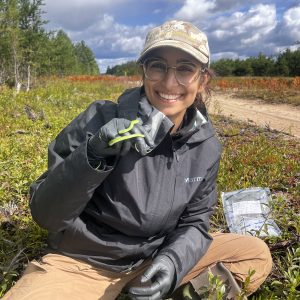
Hi, my name is Hannah and I am a second year master’s student in Dr. Chris Kozackiewicz’s lab at the W.K. Kellogg Biological Station. I am interested in how the severity and prevalence of disease varies across different host species and environments. Specifically, I want to know how these dynamics play out for a fungal disease called ophidiomycosis, or snake fungal disease—SFD.
To conduct my research, I get to walk around Michigan’s forests and wetlands looking for any species of snake I can find. Once I find one, I will try to capture it and observe it for signs of infection. My favorite part of my job is when I get to bring volunteers along with me and show them how interesting and beautiful snakes really are!
Why diseases and why snakes?
SFD is usually a lot like a really bad case of athletes foot. Unfortunately, some snakes—often endangered species like Michigan’s only native rattlesnake, the Eastern Massasassauga, or EMR—experience this disease much more severely than others and eventually die. While we can all take a breath and relax knowing that humans can’t be infected by this gnarly fungus, we should still be concerned about the long-term impacts this disease can have on our native snakes and consequently our native ecosystems.

Despite their nefarious reputations, snakes are very important members of their ecosystems. As predators, they are vital to controlling populations of pests like rodents and other small mammals that are really good at spreading disease to humans. Snakes are also prey. They provide an important source of food for birds, mammals, and even other snakes!
Because snakes play such an important role in their ecosystems, it’s important to understand how diseases like SFD threaten their survival. My research looks at how this disease affects Michigan’s snakes and why it shows up differently in different places. For example, are snakes in wetlands more at risk than those in drier habitats? And are some snake species naturally better at fighting off the infection than others? By answering these questions, I hope to give conservation managers better tools to protect vulnerable species and keep Michigan’s ecosystems healthy and balanced.
Looking forward
As a kid, I always found it easier to learn a new topic when I could interact with it in some way. What better subject is there than ecology—study of the relationships and interactions between living organisms and their physical environment—to practice hands-on learning. This year, I hope to get teachers, students, and anyone else who is interested excited about the nature in their neighborhoods and backyards by leading workshops and field trips that encourage a more modern view of what nature can be and how we can appreciate it no matter where we are.
~~~~~~~~~~~~~~~~~~~~
Hannah Rothkopf is a master’s student in the Kozackiewicz Lab at the W.K. Kellogg Biological Station and a 2025-26 KBS science education and outreach fellow.–
~~~~~~~~~~~~~~~~~~~~

A legacy of conservation; a commitment to sustainability.
3700 E. Gull Lake Drive
Hickory Corners, MI 49060
(269) 671-5117
info@kbs.msu.edu